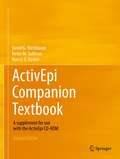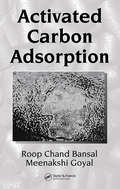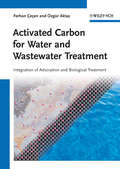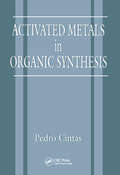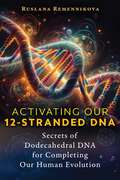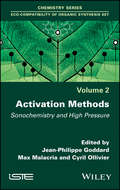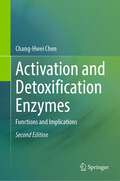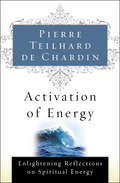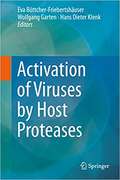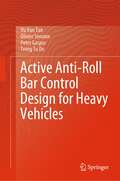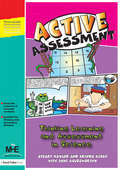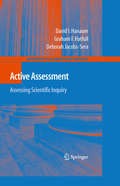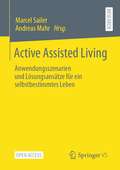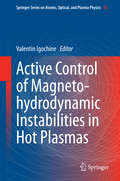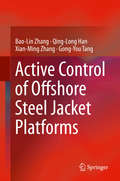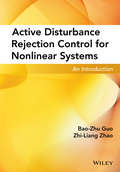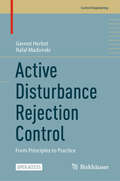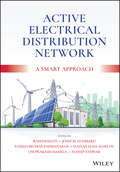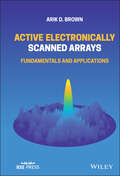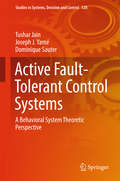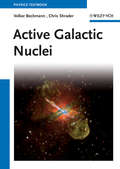- Table View
- List View
ActivEpi Companion Textbook: A supplement for use with the ActivEpi CD-ROM
by David G. Kleinbaum Kevin M. Sullivan Nancy D. BarkerThis Companion Textbook supplements the ActivEpi CD-ROM, sold separately. The ActivEpi CD-ROM provides a multimedia presentation of concepts, commonly taught in an introductory epidemiology course. ActivEpi mixes a full array of media to motivate, explain, visualize and apply epidemiological concepts. Virtually all of the material on the ActivEpi CD-ROM is included in the Companion Textbook. Because individuals differ in their learning skills, the ActivEpi CD-ROM and the ActivEpi Companion Textbook offer readers different but related options on how to learn epidemiology. The Textbook can be used as a hardcopy reference of the textual materials contained on the CD-ROM, as a resource for the practice exercises, as a general reference, or even a self-contained textbook. ActivEpi includes 15 lessons and over 50 hours of content via more than 250 launchable activities and homework exercises. It can be used in a variety of teaching formats: distance learning, self-paced learning, on-campus courses, and short courses. For the latest additions to ActivEpi, visit David Kleinbaum's website.
Activated Carbon Adsorption
by Roop Chand Bansal Meenakshi GoyalHigh surface area, a microporous structure, and a high degree of surface reactivity make activated carbons versatile adsorbents, particularly effective in the adsorption of organic and inorganic pollutants from aqueous solutions. Activated Carbon Adsorption introduces the parameters and mechanisms involved in the activated carbon adsorption
Activated Carbon for Water and Wastewater Treatment: Integration of Adsorption and Biological Treatment
by Özgür Aktas Ferhan CecenThis monograph provides comprehensive coverage of technologies which integrate adsorption and biological processes in water and wastewater treatment. The authors provide both an introduction to the topic as well as a detailed discussion of theoretical and practical considerations. After a review of the basics involved in the chemistry, biology and technology of integrated adsorption and biological removal, they discuss the setup of pilot- and full-scale treatment facilities, covering powdered as well as granular activated carbon. They elucidate the factors that influence the successful operation of integrated systems. Their discussion on integrated systems expands from the effects of environmental to the removal of various pollutants, to regeneration of activated carbon, and to the analysis of such systems in mathematical terms. The authors conclude with a look at future needs for research and develoment. A truly valuable resource for environmental engineers, environmental and water chemists, as well as professionals working in water and wastewater treatment.
Activated Metals in Organic Synthesis (New Directions In Organic And Biological Chemistry Ser.)
by P. CintasActivated Metals in Organic Synthesis discusses fundamental principles of the generation of activated, highly reactive metals, and their applications in organic synthesis. Following an introductory chapter on basic forms of metals the chapters in Part 1 are devoted to common strategies utilized for the preparation of active metals. These strategies include vaporization and subsequent co-condensation of metal atoms, in addition to depassivating methods employed commonly in laboratory syntheses. Chapters in Part 2 discuss relevant organic transformations in which metal activation plays a crucial role. Specific topics covered include metal-induced reductive methods; pinacolic, Reformatsky-, and Barbier-type reactions; McMurry ketone-olefin coupling; and the Bernet-Vasella reaction. Each chapter is followed by literature citations ranging from specific references to significant reviews. Many structural formulas are provided, making it easy to follow each synthesis. The book will be an important reference for students, organic chemists, and researchers in all areas of organometallic chemistry.
Activating Our 12-Stranded DNA: Secrets of Dodecahedral DNA for Completing Our Human Evolution
by Ruslana Remennikova• Reveals how vibration and intention can transform DNA from the standard double helix to its 12-stranded form, unlocking your physical and spiritual potential• Explores the intimate relationship of water and DNA and how they both react to sound and consciousness• Shares ten specific frequencies that resonate with DNA as well as techniques and meditations to activate your 12-stranded DNA for emotional and physical healing, resolution of ancestral trauma, and conscious evolutionIn this vibrant guidebook, sound healer and former corporate scientist Ruslana Remennikova reveals how, through vibration and intention, you can shapeshift DNA from the standard double helix to its 12-stranded, dodecahedral form—thereby unlocking your spiritual potential and opening the way for deep healing of the past, the present, and the future of your deeper self.Examining the alchemy behind the 12 strands of our DNA, the author looks at the intimate relationship between water and DNA, showing how both respond to vibrational frequencies as well as to consciousness. She also shows how unresolved grief creates oxidative stress in the body that targets our cellular mitochondrial DNA, leading to psychological and physical illnesses. She explains how sound can transform our DNA into an evolutionary activator and healing mechanism, helping the body to detox, resolve grief and trauma, and address stress-induced imbalances at the cellular level.Sharing techniques and meditations that help you activate all 12 strands of your DNA, the author reveals the revolutionary healing powers inherent in each of us for personal healing, spiritual transformation, and the completion of our human evolution.
Activation Methods: Sonochemistry and High Pressure
by Jean-Philippe Goddard Max Malacria Cyril OllivierActivation Methods examines recent improvements in the utilization of ultrasonic waves and pressurized gases to generate reactions. A straightforward method to use, sonochemistry allows chemical reactions to be carried out under ultrasound without the need for external heat, reagents or catalysts – leading to high yields and the production of a minimum amount of waste. This book presents an overview of the main applications of sonochemistry in green organic chemistry, with an emphasis on texts published within the last few years. High-pressure chemical reactions offer innovative solutions to problems relating to synthesis. They allow access to new products and a further understanding of reaction mechanisms. This book presents the characteristics of hyperbaric activation, which allow the integration of an arsenal of tools for green chemistry, such as the lowering of energy costs and of by-products, as well as the possibility of using substrates that are sterically congested and generally inert.
Activation and Detoxification Enzymes: Functions and Implications
by Chang-Hwei ChenHumans are exposed to foreign compounds such as drugs, household products and environmental chemicals by swallowing or breathing. Also, food is considered a foreign compound. Such foreign compounds can be non-essential and non-functional to life, and commonly are referred to as xenobiotics. Some xenobiotics are not toxic; however, many of them are potentially toxic or become toxic after conversion to metabolic intermediates. A considerable number of foreign compounds belong to non-polar, lipophilic substances. Lipophilic compounds are not soluble in water. Metabolic conversion of lipophilic foreign compounds to facilitate their removal from the body is essentially carried out by biochemical reactions catalyzed by two classes of metabolizing enzymes, namely, activation enzymes and detoxification enzymes. Activation enzyme-catalyzed functionalization reaction introduces a functional group to a lipophilic compound. Functionalization modifies many foreign compounds to form reactive intermediates capable of interacting with cellular components (proteins, DNA and lipids), leading to a variety of conditions for diseases. Functionalized compounds are further metabolized through detoxification enzyme-catalyzed reactions, which result in an increase in the solubility of parent compounds and an inactivation of metabolic intermediates, thus facilitating their excretion from the body. To minimize the exposure of potentially toxic metabolic intermediates, it is essential to keep them at a minimum level. Extensive investigations have revealed that foreign compound-metabolizing enzymes exhibit genetic polymorphisms. Variations in their activities can produce different results as to the susceptibility to potential toxic effects. Moreover, the expressions of activation enzymes and detoxification enzymes are inducible. A number of chemical compounds are capable of acting as modulators for these two classes of enzymes. These findings have lead to the proposal of modulating metabolizing enzymes as a useful approach for human health benefits. Importantly, many of these chemical compounds are present in human daily diets. There are many advances that have been made in the past decades towards the understanding of functions and implications of activation enzymes and detoxification enzymes. An organized, concise overview is needed for the readers who are initially exposed to this important subject, particularly for students and researchers in the areas of biomedical sciences, biochemistry, nutrition, pharmacology and chemistry. This book is intended to serve this purpose as an introduction to the subject. Furthermore, major topics in the book, excluding catalytic reactions and structural properties, may have interest to other readers who have knowledge of basic sciences and understanding enzyme related information. The book discusses subjects associated with foreign compound metabolizing enzymes with emphasis on biochemical aspects, including lipophilic foreign compounds, catalytic properties, reactive intermediates, biomedical and biochemical effects, genetic polymorphisms, enzyme inducibility, enzyme modulation for health benefits, dietary related enzyme modulators, and structural characteristics of enzyme inducers.
Activation and Detoxification Enzymes: Functions and Implications
by Chang-Hwei ChenThis book discusses the many advances in the understanding of the functions and implications of activation and detoxification enzymes. This organized, concise overview will meet the needs of those who are initially exposed to this important subject, particularly for students and researchers in the areas of biomedical sciences, biochemistry, nutrition, pharmacology, and chemistry. The book will also be valuable to advanced researchers. The book discusses subjects associated with foreign-compound-metabolizing enzymes with emphasis on biochemical aspects, including lipophilic foreign compounds, activation and detoxification enzymes, metabolic enzyme catalytic properties, reactive metabolic intermediates, biomedical and biochemical effects, genetic polymorphisms, enzyme inducibility, enzyme modulation for health benefits, dietary-related enzyme modulators, and structural characteristics of enzyme inducers. This new edition is updated throughout andfeatures completely new chapters on Oxidative and Electrophilic Stresses, Metabolite- Mediated Disease Conditions, and Defense Mechanism: Nrf2-ARE Pathway.
Activation of Energy: Enlightening Reflections on Spiritual Energy
by Pierre Teilhard de ChardinThe renowned Jesuit thinker explores science, theology, and the course of human evolution. Following in the footsteps of his earlier works, this collection of essays from Pierre Teilhard de Chardin brings greater clarity to the stunning potential of human energy if it is properly channeled, as he describes, &“upward and outward.&” While energy wrongly directed appears as depression, drug addiction, and violence, this legendary scholar—a priest who earned a doctorate in geology and studied the sciences extensively—promises that spiritual energy channeled correctly will become a true force in the universe, far outdistancing the potential of technological advance. &“Like other great visionary poets—Blake, Hopkins, Yeats—Teilhard engages the reader both intellectually and sensually.&” —The Washington Post Book World
Activation of Viruses by Host Proteases
by Eva Böttcher-Friebertshäuser Wolfgang Garten Hans Dieter KlenkPresents recent findings on this topic.<P><P> Deals with all aspects of the role of proteases in virus activation.<P> Explores the topic from different points of view.<P>This book will give an overview on viruses undergoing proteolytic activation through host proteases. The chapters will be organized in three themed parts, the first part describing respective viruses and their characteristics in detail. In the second part the molecular and cellular biology of the proteases involved as well as their physiological functions will be further explored. The third part will contain a chapter on protease inhibitors that are promising tools for antiviral therapy.<P> This book will engage scholars in virology and medical microbiology as well as researchers with an interest in enzymology and protein structure and function relationship.
Active Anti-Roll Bar Control Design for Heavy Vehicles
by Olivier Sename Peter Gaspar Vu Van Tan Trong Tu DoThis book provides a comprehensive overview of active anti-roll bar systems on heavy vehicles as one of the most effective solutions for improving the roll stability of these vehicles. Due to the characteristics of these vehicles with heavy loads and high center of gravity, the possibility of roll instability occurs frequently and causes serious consequences for human life, vehicles, and traffic infrastructure. The book gives readers an in-depth survey of the roll instability characteristics of heavy vehicles such as single-unit trucks with rigid and flexible frames, and tractor semi-trailers. It then introduces an active anti-roll bar system, the electro-hydraulic actuators which use control methods such as LQR optimal and H∞ robust controller design. This work introduces a new control method, which is a combination of robust control with the linear parameter varying system (H∞/LPV). The validation of the new hybrid method is carried out using the nonlinear truck model from the TruckSim® software to assess the roll stability of heavy vehicles in order to limit the rollover accident. A number of examples are provided to illustrate the research results, which helps the readers have a practical and easy approach that can be applied to other active anti-roll bar systems for most forms of transport vehicles in general. This book caters to academics and practitioners who are interested in active anti-roll bar systems for the typical heavy vehicle available worldwide.
Active Assessment for Science: Thinking, Learning and Assessment in Science
by Anne Goldsworthy Brenda Keogh Stuart NaylorEverybody seems to be talking about assessment for learning. This book shows how to do it. Using a highly creative approach it explains in detail how assessment, thinking and learning can be integrated in science lessons. More than 30 different assessment techniques are described, with each one illustrated for two different age ranges.Concise teachers' notes for each technique explain:what the approach ishow you use it for assessmenthow you can manage it in the classroomhow it helps with learning.Electronic versions of the activities are provided on the accompanying downloadable resources.
Active Assessment: Assessing Scientific Inquiry (Mentoring in Academia and Industry #2)
by David I. Hanauer Debbie Jacobs-Sera Graham F. HatfullThe book is designed to provide a theoretical introduction to the field of active assessment, a practical guide to the development of assessment tools for scientific inquiry and a case study of a specific development and implementation process of assessment in a scientific inquiry program. As currently designed the book would have two sections: the first, theoretical and practical developing the concepts of how assessment is developed and implemented and the second section, a case study from research work conducted in the outreach program of the Bacteriophage Institute of Pittsburgh. The book is designed for a wide market of scientists involved in scientific education laboratory work. As with the original research project, this book breaks new ground in the area of scientific education and assessment and at this current time there is no book or research monograph that explicates a serious, comprehensive approach to the assessment of scientific inquiry. It is important to note that according to all the central bodies involved in science education (see the National Research Council's standards for science education) that the use of scientific inquiry is the preferred method of teaching science. Accordingly a book of this type should provide an important service for all active scientific inquiry programs in that it presents for the first time a concept and method for assessing scientific inquiry on the undergraduate and graduate levels. This book could provide an interesting answer to this situation of a required educational context without developed methodologies for evaluation.
Active Assisted Living: Anwendungsszenarien und Lösungsansätze für ein selbstbestimmtes Leben
by Marcel Sailer Andreas MahrIn dem vorliegenden Open-Access-Buch identifizieren Studierende und Lehrende interprofessionell Entwicklungen und Problemfelder der Assistiven Technologien. Diese halten zunehmend Einzug ins Leben versorgungsbedürftiger, häufig älterer Menschen. Nach einigen Jahren der Entwicklung kann konstatiert werden, dass der Transfer von Entwicklung zur Anwendung im Alltag infolge unterschiedlicher Perspektiven und Zielsetzungen nur unzureichend stattfindet. Die Beitragsautoren bieten kreative Lösungsansätze, die zu einer nachhaltigen Umsetzung führen sollen.Dies ist ein Open-Access-Buch.
Active Biology
by Ruta Demery Robert RitterActive Biology has fascinating challenges that ask you to use your creativity, interests, and expertise to complete challenges in the same way professionals do. You will learn about the incredible variety of organisms that inhabit the earth and how they have adapted to their environment. You will investigate competition among organisms and the process of natural selection. You will discover the factors that affect population size. And you will understand that the extinction of one organism can affect an entire ecosystem.
Active Chemistry
by Arthur Eisenkraft It'S About Time Gary Freebury American Institute of Chemical Engineers StaffActive Chemistry makes learning chemistry relevant, fun, and exciting. Chemistry is involved in every aspect of your life - from the way your body works to the things you like to do.
Active Chemistry
by Arthur EisenkraftThe highlighting features of this Chemistry text book are: Scenario, Chapter Challenge, Criteria, What Do You Think?, Investigate, Chem Talk, Chem Words, Checking Up, Reflecting on the Activity and the Challenge, Chemistry to Go, Preparing for the Chapter Challenge, Challenge Assessment, Chemistry at Work and Photos and Illustrations.
Active Control of Magneto-hydrodynamic Instabilities in Hot Plasmas (Springer Series on Atomic, Optical, and Plasma Physics #83)
by Valentin IgochineDuring the past century, world-wide energy consumption has risen dramatically, which leads to a quest for new energy sources. Fusion of hydrogen atoms in hot plasmas is an attractive approach to solve the energy problem, with abundant fuel, inherent safety and no long-lived radioactivity. However, one of the limits on plasma performance is due to the various classes of magneto-hydrodynamic instabilities that may occur. The physics and control of these instabilities in modern magnetic confinement fusion devices is the subject of this book. Written by foremost experts, the contributions will provide valuable reference and up-to-date research reviews for "old hands" and newcomers alike.
Active Control of Offshore Steel Jacket Platforms
by Qing-Long Han Bao-Lin Zhang Xian-Ming Zhang Gong-You Tang<p>Offshore platforms are widely used to explore, drill, produce, store and transport ocean resources, and are usually subjected to environmental loading, which can lead to deck facility failure and platform fatigue failure, inefficient operation and even crew discomfort. In order to ensure the reliability and safety of offshore platforms, it is important to explore effective ways of suppressing the vibration of offshore platforms. <p>This book provides a brief overview of passive, semi-active and active control schemes to deal with vibration of offshore platforms. It then comprehensively and systematically discusses the recent advances in active systems with optimal, sliding model, delayed feedback and network-based control. Intended for readers interested in vibration control and ocean engineering, it is particularly useful for researchers, engineers, and graduate students in the fields of system and control community, vibration control, ocean engineering, as well as electrical and electronic engineering.</p>
Active Disturbance Rejection Control for Nonlinear Systems: An Introduction
by Bao-Zhu Guo Zhi-Liang ZhaoA concise, in-depth introduction to active disturbance rejection control theory for nonlinear systems, with numerical simulations and clearly worked out equations Provides the fundamental, theoretical foundation for applications of active disturbance rejection control Features numerical simulations and clearly worked out equations Highlights the advantages of active disturbance rejection control, including small overshooting, fast convergence, and energy savings
Active Disturbance Rejection Control: From Principles to Practice (Control Engineering)
by Gernot Herbst Rafal MadonskiThis open access text offers the first comprehensive introduction to the fundamental principles and practical implementation of Active Disturbance Rejection Control (ADRC). Drawing on their years of experience in both research and industry, the authors have designed the text to be accessible to readers at any level of knowledge and experience with ADRC. Multiple entry points and paths through the text are defined so that it can be easily adapted to their specific needs. Part I covers the theoretical foundations of ADRC, giving readers the basic information in a self-contained, tutorial style. Emphasis is placed on first developing an intuition for ADRC through illustrative examples inspired by real control problems. The main concepts are then introduced and explored in a more formal and concise manner using standard control-domain-related terminology. Part II demonstrates methods for applying ADRC in practice through software-based implementation. Utilizing laboratory testbeds to mimic real control problems from process and control areas, the authors illustrate the use of software through both model-based environments - including MATLAB/Simulink - and low-level C programming language. Common issues that one can encounter when implementing controllers in the real world are also examined, and specific solutions to these problems are offered that retain the simplicity of ADRC. This book can be used as a textbook, handbook, or reference manual, and through its many entry points, can be easily picked up by students, practitioners, and scientists. Having in mind its introductory nature, the prerequisites for studying the considered subject are intentionally not very strict. Readers should have at least basic knowledge of systems and controls, as well as an understanding of core mathematical concepts of calculus, linear algebra, and differential equations.
Active Electrical Distribution Network: A Smart Approach
by Sudeep Tanwar Hassan Haes Alhelou Sanjeevikumar Padmanaban Baseem Khan Josep M. Guerrero Om Prakash MahelaACTIVE ELECTRICAL DISTRIBUTION NETWORK Discover the major issues, solutions, techniques, and applications of active electrical distribution networks with this edited resourceActive Electrical Distribution Network: A Smart Approach delivers a comprehensive and insightful guide dedicated to addressing the major issues affecting an often-overlooked sector of the electrical industry: electrical distribution. The book discusses in detail a variety of challenges facing the smart electrical distribution network and presents a detailed framework to address these challenges with renewable energy integration.The book offers readers fulsome analyses of active distribution networks for smart grids, as well as active control approached for distributed generation, electric vehicle technology, smart metering systems, smart monitoring devices, smart management systems, and various storage systems. It provides a treatment of the analysis, modeling, and implementation of active electrical distribution systems and an exploration of the ways professionals and researchers from academia and industry attempt to meet the significant challenges facing them.From smart home energy management systems to approaches for the reconfiguration of active distribution networks with renewable energy integration, readers will also enjoy:A thorough introduction to electrical distribution networks, including conventional and smart networksAn exploration of various existing issues related to the electrical distribution networkAn examination of the importance of harmonics mitigation in smart distribution networks, including active filtersA treatment of reactive power compensation under smart distribution networks, including techniques like capacitor banks and smart devicesAn analysis of smart distribution network reliability assessment and enhancementPerfect for professionals, scientists, technologists, developers, designers, and researchers in smart grid technologies, security, and information technology, Active Electrical Distribution Network: A Smart Approach will also earn a place in the libraries of policy and administration professionals, as well as those involved with electric utilities, electric policy development, and regulating authorities.
Active Electronically Scanned Arrays: Fundamentals and Applications (IEEE Press)
by Arik D. BrownIn Active Electronically Scanned Arrays: Fundamentals and Applications, electromagnetics expert Dr. Arik D. Brown delivers a foundational treatment of active electronically scanned arrays (AESAs) ideal for engineering students and professionals. The distinguished author provides an overview of the primary subsystems of an AESA and detailed explanations of key design concepts and fundamentals for subsystems, including antenna array elements, transmit/receive modules, and beamformers. Performance results for various AESA architectures often found in industry, including analog, subarrayed, and digital beamforming AESAs, are discussed. With a focus on practical knowledge and applications, Active Electronically Scanned Arrays: Fundamentals and Applications offers an accessible overview of a technology critical to the implementation of collision avoidance in cars, air surveillance radar, communication antennas, and defense technologies. The book also includes: A thorough introduction to AESAs, including a top-level block diagram view and explanations of key components and subsystems Detailed explanations of the impact of AESAs on mission applications including Radar, Electronic Attack (EA), Electronic Support Measures (ESM), SIGINT and Communications Comprehensive explorations of antenna array elements, transmit/receive modules, and beamformers including their purpose, functions, and practical design considerations In-depth examinations of AESA architecture performance for current and future systems Utility of AESAs for implementing adaptive beamforming for Electronic Counter-Countermeasures (ECCM) Perfect for electrical engineers working with active electronically scanned arrays, electronic warfare technologies, radar, or communications, Active Electronically Scanned Arrays: Fundamentals and Applications will also prove to be an invaluable resource for defense students undertaking military education and training.
Active Fault-Tolerant Control Systems: A Behavioral System Theoretic Perspective (Studies in Systems, Decision and Control #128)
by Tushar Jain Joseph J. Yamé Dominique SauterThe book introduces novel algorithms for designing fault-tolerant control (FTC) systems using the behavioral system theoretic approach, and presents a demonstration of successful novel FTC mechanisms on several benchmark examples. The authors also discuss a new transient management scheme, which is an essential requirement for the implementation of active FTC systems, and two data-driven methodologies that are broadly classified as active FTC systems: the projection-based approach and the online-redesign approach. These algorithms do not require much a priori information about the plant in real-time, and in addition this novel implementation of active FTC systems circumvents various weaknesses induced by using a diagnostic module in real-time. The book provides graduate students taking masters and doctoral courses in mathematics, control, and electrical engineering an excellent stepping-stone for their research. It also appeals to practitioners interested to apply innovative fail-safe control techniques.
Active Galactic Nuclei
by Chris Shrader Volker BeckmannActive Galactic Nuclei This AGN textbook gives an overview on the current knowledge of the Active Galacitc Nuclei phenomenon. The spectral energy distribution will be discussed, pointing out what can be observed in different wavebands. The different physical models are presented together with formula important for the understanding of AGN physics. Furthermore, the authors discuss the AGN with respect to its environment, host galaxy, feedback in galaxies and in clusters of galaxies, variability, etc. and finally the cosmological evolution of the AGN phenomenon. This book includes phenomena based on new results in the X-Ray and gamma-ray domain from new telescopes such as Chandra, XMM-Newton, the Fermi Gamma-Ray Space Telescope, and the VHE regime not mentioned so far in AGN books. Those and other new developments as well as simulations of AGN merging events and formations, enabled through latest super-computing capabilities. From the contents: The observational picture of AGN Radiative processes The central engine AGN types and unification AGN through the electromagnetic spectrum AGN variability Environment Quasars and cosmology Formation, evolution and the ultimate fate of AGN What we do not know (yet)
